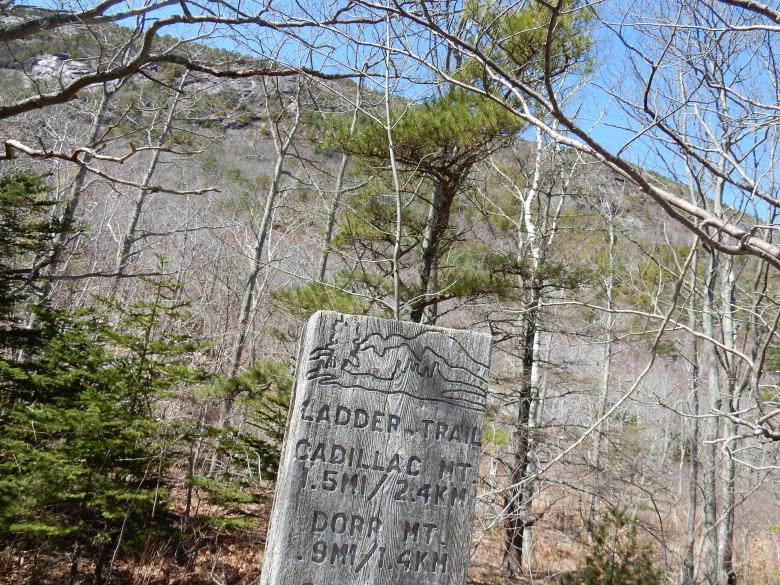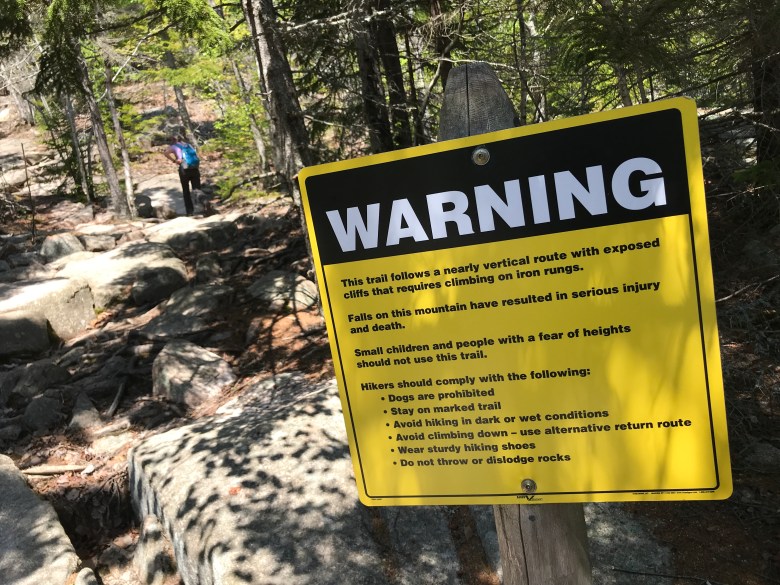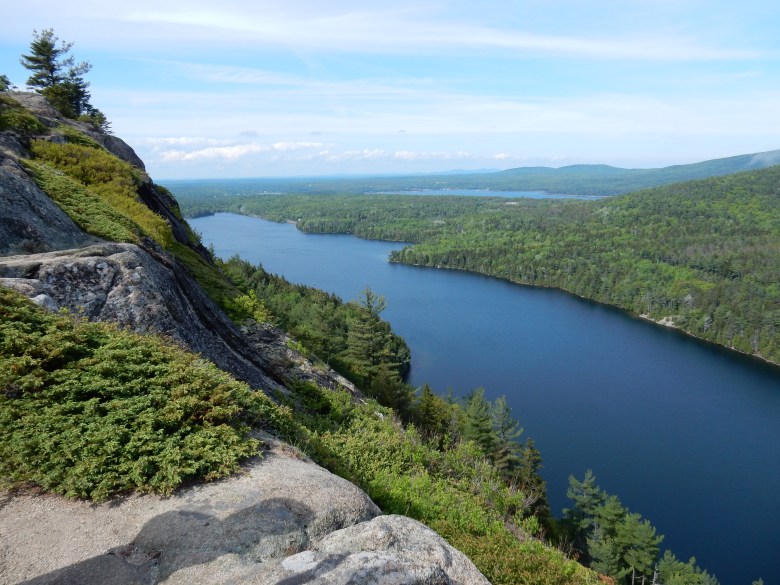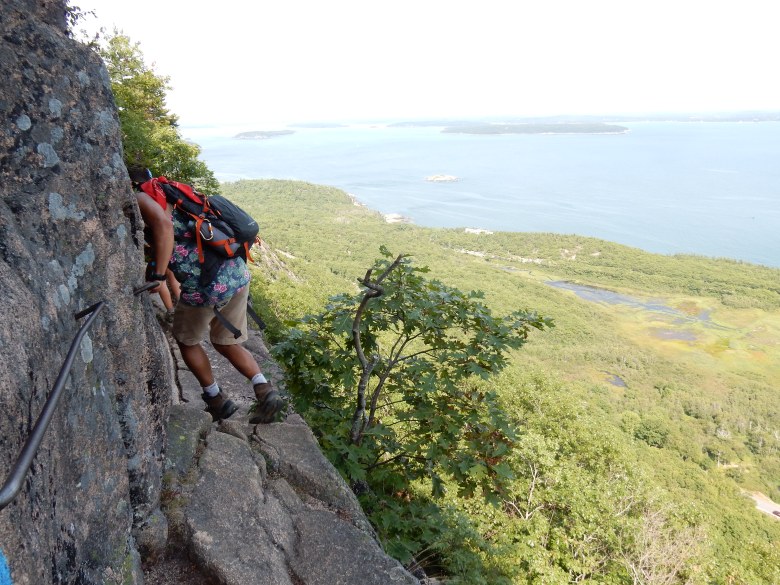
More than 120 miles of historic hiking trails crisscross Acadia National Park on Mount Desert Island, allowing walkers virtually unlimited opportunities to explore the wonders of this place, one of the most beloved and visited parks in the U.S. There are footpaths through the forested valleys, trails marked with rock cairns that climb over the ridges and summits, and routes constructed using stone and iron work.
It is in this latter category that you’ll find perhaps the park’s most notable (notorious?) trails, and among these, a handful of rugged and rigorous paths stand out as true masterpieces of trail engineering. These include the Precipice Trail, the Beehive Trail, the Ladder Trail, the Jordan Cliffs Trail and the Beech Cliffs Trail.
To climb these “ladder” trails is to throw caution to the proverbial wind. Locally quarried granite steps and staircases lead hikers on spiraling tracks up impossibly steep escarpments, with nothing but air below as you negotiate narrow catwalks and cling to iron rungs, railings and ladders. Each is an exhilarating experience and entirely worth the strenuous effort, sweaty palms and wobbly knees.
The earliest trails on MDI were canoe carry paths created by the native Wabanaki to connect the lakes and ponds. Later, English settlers widened these trails into cart paths and extended them to link farms and logging camps to coastal hamlets. Beginning in the 1850s with the arrival of the “rusticators,” wealthy East Coast city dwellers drawn to the island’s beauty, formal recreational paths were developed to lead these summer tourists to the high summits and seaside lookouts.
In the 1890s, four village improvement associations as well as the Hancock County Trustees of Public Reservations were created, all out of concerns about overdevelopment, logging, railroads and auto roads on the island. These actions preceded the establishment of Sieur de Monts National Monument in 1916, which became Lafayette National Park three years later, and was renamed Acadia in 1929.
Rudolph Brunnow served as chair of the Bar Harbor Village Improvement Association from 1912 to 1917. Brunnow, working though the group’s Roads and Paths Committee, is responsible for designing the remarkable Precipice Trail on Champlain Mountain, which ascends the precipitous east face through rock fissures, across talus slopes and over sharp ledges to a spectacular 360-degree summit panorama.
Brunnow’s handiwork also extended to the nearby Beehive and today’s Beehive Trail, which was originally known as the Little Precipice Trail. Shorter in length but no less exposed and exciting than Precipice Trail, the Beehive Trail is a wonder of trail construction that leads in dramatic fashion to wonderful views of Sand Beach, Great Head and Frenchman Bay.
The Ladder Trail ascends the steep slabs on the east slope of Dorr Mountain, connecting the Kane Path near the Tarn to the Schiff Path at the 800-foot elevation contour. The trail was built in the late 1890s under the supervision of Herbert Jacques of the BHVIA, and in the mid-1930s, it was rebuilt and parts of it relocated by the Civilian Conservation Corps. From the top of Ladder Trail, scamper to the top of Dorr for a fine panoramic vista.
The Jordan Cliffs Trail crosses the sharp east face of Penobscot Mountain, following a rising contour above magnificent Jordan Pond. Originally known as the Jordan Bluffs Trail (circa late 1890s), the wild traverse of the 500-foot cliffs is the work of Waldron Bates, the indefatigable trail builder for whom the “Bates Cairn” is named. You’ll find these unique cairns — constructed of two to four base stones, a lintel stone and a pointer rock — marking the bare rock sections of Acadia’s mountain paths.
The Beech Cliff Trail starts just above shores of scenic Echo Lake near its popular sandy beach. The short (half-mile) but steep trail, built in the 1930s by the CCC, ascends through the woods of the great cliff face via a series of stone steps, angle iron ladders and cable railings. Scale the route, and you are rewarded with a sweet bird’s-eye view over the lake and its mountainous surroundings.
From the end of World War II to the present day, Acadia’s trails have been meticulously maintained by the park’s amazing trail crews. For more background on MDI’s trails, read the fascinating “Trails of History” by Tom St. Germain and Jay Saunders.
Note: Precipice Trail, Jordan Cliffs Trail and select other trails are closed from late winter through mid-August each year to protect nesting peregrine falcons. Visit go.nps.gov/peregrine for more details.
Carey Kish of Mount Desert Island is a Triple Crown hiker, freelance writer and author of three hiking guides. Connect with Carey on Facebook and Instagram and at [email protected].




















We invite you to add your comments. We encourage a thoughtful exchange of ideas and information on this website. By joining the conversation, you are agreeing to our commenting policy and terms of use. More information is found on our FAQs. You can modify your screen name here.
Comments are managed by our staff during regular business hours Monday through Friday as well as limited hours on Saturday and Sunday. Comments held for moderation outside of those hours may take longer to approve.
Join the Conversation
Please sign into your CentralMaine.com account to participate in conversations below. If you do not have an account, you can register or subscribe. Questions? Please see our FAQs.